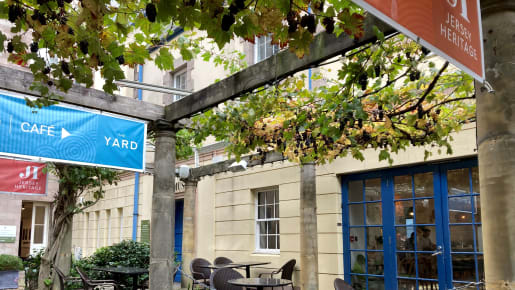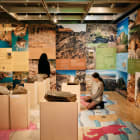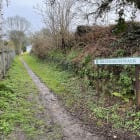
Explore the history of St Helier with this short walk
Walk Details
- 30 to 40 Minutes
- Starts at: Jersey Museum & Art Gallery
- Ends at: Jersey Museum & Art Gallery
- 1.5 Miles
- Beginner
High above you can just see the top of the Fort Regent signal station where a series of flags and symbols were used to signal the arrival and departure of vessels and also to warn of storms. This is a reminder of a time when the Island was completely dependent on the sea for the movement of people and goods.
Climb the steps to Pier Road.
On 9 May 1945 a party of British liberating soldiers climbed these steps to reach Fort Regent where they took down the Nazi flag of the defeated German occupying force and replaced it with the Union flag.
Turn left at the top of the steps and walk down Pier Road.
Pause by the entrance to the Société Jersiaise where you can see the façade of Number 9 Pier Road, now restored as a Victorian House as part of a visit to Jersey Museum. This impressive property was built by wealthy merchant Philippe Nicolle close to the historic harbour despite the fact that this was the red light district at the time. The poverty of the area is reflected in the high number of deaths of Pier Road inhabitants during the cholera epidemic of 1832.
Continue down the hill and cross the main road into Bond Street.
On the right is the Town Church which is dedicated to Saint Helier who was beheaded by raiding pirates in 555 AD while living on a rocky outcrop in St Aubin’s Bay, now the site of the Hermitage at Elizabeth Castle.
At the end of Bond Street, turn right and pause by the Obelisk monument.
This was built in honour of Pierre Le Sueur, a former Constable of St Helier, who worked tirelessly to improve the living conditions of the poor in the parish, especially by building a town sewerage system to combat the threat of cholera.
Turn right by the Blue Note pub and then left into King Street.
Walk as far as La Croix de la Reine, the granite cross erected for the Queen’s Silver Jubilee in 1977.
Turn right into Pitt Street.
At the end of the road, stop to admire the hand-painted HMV sign on the gable wall of Locke’s coffee shop. It was originally painted to advertise Francis Foot’s shop, one of the first gramophone and record dealers in the Island. This cluster of historic buildings has been carefully restored by the National Trust for Jersey in recent years.
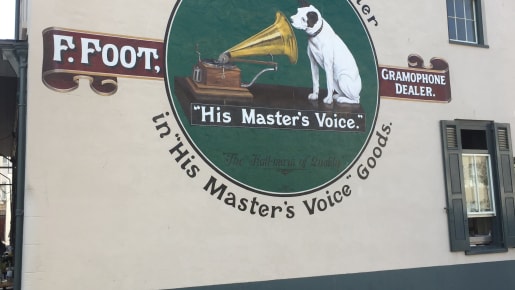
HMV Sign
Walk along Dumaresq Street past the rear entrance of De Gruchy’s department store. Turn right and walk past St Paul’s Centre.
This building was opened in 1871 as New Street School – note the separate entrances marked Boys and Girls.
Continue past the Centre and turn right on to New Street.
On your left is St Paul’s Church. The original church was built in 1815 to provide for the rapidly-growing population of St Helier. However, it was built on marshy ground and had to completely re-built in the 1890s.
Opposite the church stands the Georgian House, an important example of an early Georgian town house. It was built around 1730 by Philippe Patriarche and was designed in the English manner. It was used as the Liberty Gentlemen’s Club from 1870-1909 and was then rented to YMCA until 1964. Over the years it fell into disrepair but it was gifted to the National Trust for Jersey in 2003 and underwent a painstaking restoration. It is now open as a visitor attraction.
Head towards King Street.

Georgian House
On either side of New Street stand the Island’s two major historic department stores, De Gruchy’s and Voisin’s. Both businesses were started in the early 19th century in response to the growing demand for fine goods from the Island’s new English residents. In the Victorian period, Jersey had a low cost of living, mild climate and good steamship links which made it a popular residence for retired army officers and ex-pats from the colonies.
Turn left into King Street and take the first right into Brook Street by Hamon’s haberdashery shop.
This long-established shop retains many of its original wooden shop fittings.
Turn left into Library Place.
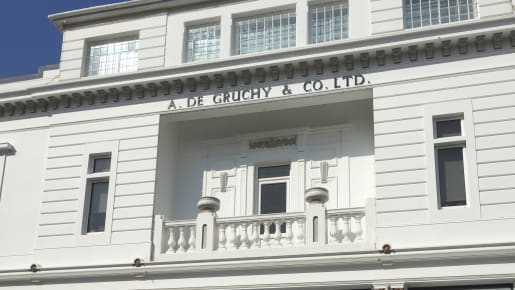
De Gruchy Department Store
Notice the very fine Baroque-style building with clock face that makes the corner. This was originally built in 1864 to house The Channel Islands Bank and this area of St Helier housed many of the Island’s historic banks.
On the opposite of the road stands a rare survival of an early 18th century building in St Helier, now the home of the Alliance Française. The building is also significant for being an early example of a public library, possibly the first in the British Isles, dating back to 1742.
Head into the Royal Square.
On the left is the Piquet House, built in 1803 to house a detachment of soldiers to help the Honorary Police in times of trouble. Note the sundial in the side wall which has an inscription encouraging people to set their watches to Jersey time rather than Greenwich Mean Time, which is 8 minutes different. Jersey signed up to Greenwich Mean Time in 1898.
The Royal Square itself has been at the centre of Island life for centuries. It was the town’s original marketplace and the scene of the Battle of Jersey. It contains the States Chamber and the Royal Court as well as one of the oldest Chambers of Commerce in the world. There are two historic pubs at one end of the Square and a Victorian gentlemen’s club at the other. It has been the scene of military parades and countless public demonstrations. But one of the greatest controversies was the planting of its trees back in 1894! Would the leaves prevent people reading the clock on the Town Church? Would the shadows of the trees encourage prostitutes to gather and ply their trade? And most importantly, would it just look too French?
Head past the Town Church and down Mulcaster Street.

Sundial
On the left is the Lamplighter, originally a Victorian pub called The Grapes. The ornate carvings were made by “Turnkey” Giffard, an ex-prison warder and grocer, who set up as monumental mason in 1877.
Turn left by the Royal Yacht Hotel.
This hotel was founded in 1820 and was the venue for St Helier parish assemblies from 1830 until the Town Hall was built in 1872. It has been known as The Royal Yacht since 1890.
Head back towards the Museum.
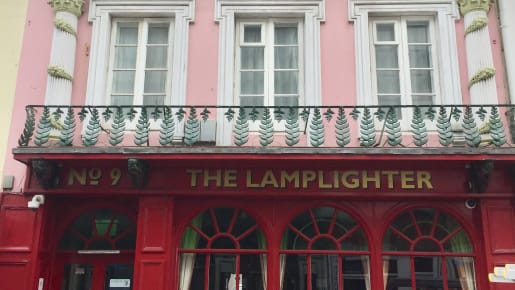
The Lamplighter
The impressive granite arch in front of the Museum recalls the founding of the Société Jersiaise in 1873 for the study of Jersey archaeology, history, natural history, the Island’s native language and the conservation of the environment.
Return to The Yard for some well-earned refreshments. If you’ve got time, why not visit Jersey Museum & Art Gallery, the ground floor is free to access and includes the Story of Jersey film

Granite Arch








